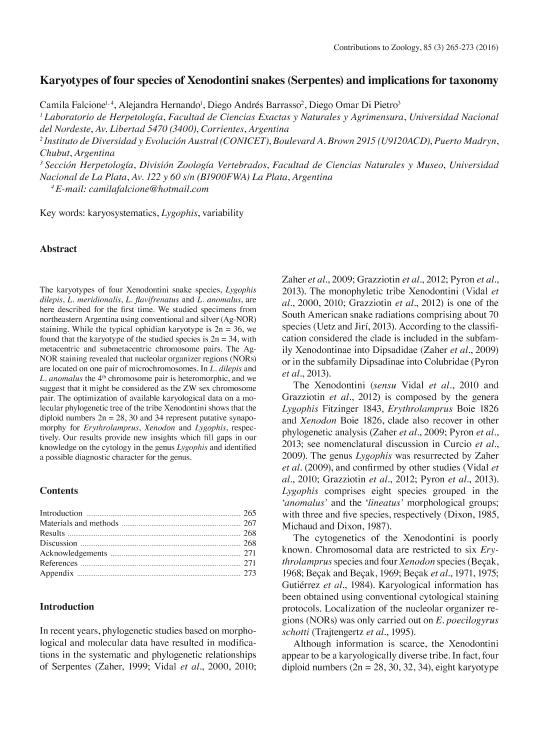Artículo
Los cariotipos de cuatro especies de serpientes, Xenodontini dilepis Lygophis , L . meridionalis , L . flavifrenatus y L . anomalus , se describen aquí por primera vez. Estudiamos especímenes del noreste de Argentina usando tinción convencional y plata (Ag-NOR). Mientras que el cariotipo de ofidio típico es 2n = 36, encontramos que el cariotipo de la especie estudiada es 2n = 34, con pares de cromosomas metacéntricos y submetacéntricos. La tinción de Ag-NOR reveló que las regiones organizadoras nucleolares (NOR) se encuentran en un par de microcromosomas. En L . dilepis y L . anomalusel 4 ° par de cromosomas es heteromorfo, y sugerimos que se lo pueda considerar como el par de cromosomas sexuales ZW. La optimización de los datos disponibles cariológicos sobre un árbol filogenético molecular de la tribu Xenodontini muestra que los números diploides 2n = 28, 30 y 34 representan supuestas sinapomorfías para Erythrolamprus , Xenodon y Lygophis , respectivamente. Nuestros resultados proporcionan nuevos conocimientos que llenan las lagunas en nuestro conocimiento sobre la citología en el género Lygophis e identificaron un posible carácter de diagnóstico para el género. The karyotypes of four South American Xenodontini snake species, Lygophis dilepis, L. meridionalis, L. flavifrenatus and L. anomalus, are here described for the first time. We studied specimens from northeastern Argentina using conventional and silver (Ag-NOR) staining. While the typical ophidian karyotype is 2n= 36, we found that the karyotype of the studied species is 2n=34, with metacentric and submetacentric chromosome pairs. The Ag-NOR staining revealed that nucleolar organizer regions (NORs) are located on one pair of microchromosomes. In L. dilepisand L. anomalus the 4th chromosome pair is heteromorphic, and we suggest that it might be considered as the ZW sex chromosome pair. The optimization of available karyological data on a molecular phylogenetic tree of the tribe Xenodontini shows that the diploid numbers of the three genera (2n= 28, 30 and 34) represent putative synapomorphies for Erythrolamprus, Xenodon and Lygophis, respectively. Our results provide new insights which fill gaps in our knowledge on the cytology in the genus Lygophis and identified a possible diagnostic character for the genus.
Karyotypes of four species of xenodontini snakes (serpentes) and implications for taxonomy
Fecha de publicación:
07/2016
Editorial:
SPB Academic Publishing
Revista:
Contributions To Zoology
ISSN:
1383-4517
e-ISSN:
1875-9866
Idioma:
Inglés
Tipo de recurso:
Artículo publicado
Clasificación temática:
Resumen
Palabras clave:
Dipsadidae
,
Karyosystematics
,
Lygophis
,
Variability
Archivos asociados
Licencia
Identificadores
Colecciones
Articulos(CCT - LA PLATA)
Articulos de CTRO.CIENTIFICO TECNOL.CONICET - LA PLATA
Articulos de CTRO.CIENTIFICO TECNOL.CONICET - LA PLATA
Articulos(CCT - NORDESTE)
Articulos de CTRO.CIENTIFICO TECNOL.CONICET - NORDESTE
Articulos de CTRO.CIENTIFICO TECNOL.CONICET - NORDESTE
Articulos(CCT-CENPAT)
Articulos de CTRO.CIENTIFICO TECNOL.CONICET - CENPAT
Articulos de CTRO.CIENTIFICO TECNOL.CONICET - CENPAT
Citación
Di Pietro, Diego Omar; Barrasso, Diego Andrés; Hernando, Alejandra Beatriz; Falcione, Ana Camila; Karyotypes of four species of xenodontini snakes (serpentes) and implications for taxonomy; SPB Academic Publishing; Contributions To Zoology; 85; 3; 7-2016; 265-273
Compartir




